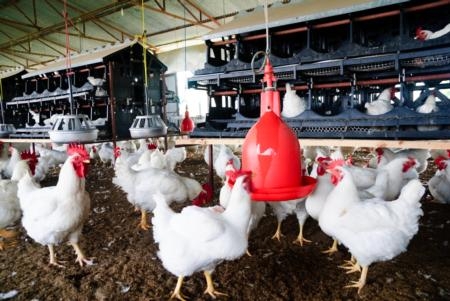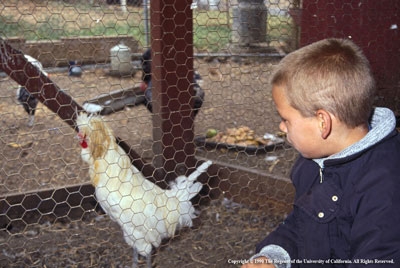Posts Tagged: eggs
Dan Sumner a part of NY Times animal cruelty debate
New laws were proposed this spring in Iowa, Minnesota and Florida that would make it a crime to take undercover videos or photos at industrial farms, a tactic often used to show mistreatment of animals and unsanitary conditions, the New York Times reported.
In response to this development, the Times invited nine experts to debate issues related to farm animal welfare. The director of the UC Agricultural Issues Center, Dan Sumner, took part in the discussion, noting that in addition to legal and moral questions, there are economic issues worth considering.
In his essay, titled Economics in the Hen House, Sumner outlined Proposition 2, a law voters approved in 2008 that ends the use of conventional cages in California egg production by 2015. Sumner said the new law will ban eggs that 95 percent of buyers now choose - less expensive, conventionally produced eggs - and allow only more expensive "free range chicken" eggs, which are already available, but rejected by the vast majority of shoppers.
He believes the use of graphic images in the campaign detracted from an informed policy debate about the potential impacts of Proposition 2. Emotional appeals with ugly images can sway a public debate, he said, while noting that farmers also use their own favored images to garner support for farm policy.
"A picture may be worth a thousand words, but sometimes a few numbers and some evidence may be worth even more," Sumner concluded.

Hen house living conditions are part of the animal welfare debate.
Any chicken can shed salmonella
Last month's enormous egg recall continues to generate news coverage about efforts to keep salmonella-contaminated eggs out of the U.S. food supply.
Experts quoted in a Los Angeles Times story published yesterday agreed that salmonella contamination can happen in any egg production system - large operations, small family farms or in the backyard. Chickens infected with salmonella shed the pathogen in their feces, which can contaminate the egg shell. In rare instances, salmonella infects a hen's ovaries and can end up inside the eggs she lays, the article said.
A Texas A&M University professor said eggs from large-scale producers should, theoretically, be safer because they are subject to state and federal regulations requiring inspections and regular testing for pathogens, including salmonella.
A Louisiana State University professor said the cages on commercial farms have slanted bottoms so eggs roll out right after they're laid, making it less likely they will come in contact with hen droppings.
Michele Jay-Russell, food safety specialist at the Western Institute for Food Safety and Security at UC Davis, told reporter Elena Conis when a foodborne illness breaks out in a large commercial concern, the problem becomes a huge, national problem very quickly. But that doesn't mean smaller-scale production is safer.
The article cited two studies comparing the occurrence of salmonella in free-range and conventionally produced eggs:
- A 1996 study published in the journal Avian Disease found higher levels of a specific type of salmonella in free-range compared to caged birds.
- A 2004 study conducted by researchers at the Poultry Microbiological Safety Research Unit at the Richard B. Russell Agricultural Research Center in Athens, Ga., found no difference in salmonella levels in free-range chickens compared to conventionally raised chickens.

Backyard producers should also take precautions to avoid foodborne illness.
Egg recall collides with California's Prop 2
As producers and government agencies continue to investigate last month's enormous recall of Iowa-produced eggs, California egg farmers are pondering whether new rules that will govern the state's hen houses will play a role in preventing or exacerbating egg-borne illness, said an article in the San Francisco Chronicle.
Proposition 2, enacted by a wide margin of California voters in 2008, will require egg producers to provide adequate room for their hens to turn around freely, lie down, stand up and fully extend their limbs.
A Humane Society of the United States spokesperson told Chron reporter Carolyn Lockhead that the evidence is "very clear" that caging laying hens increases the risk of salmonella. However, Ralph Ernst, extension poultry specialist emeritus at UC Davis, who helped write California's voluntary egg production rules, told her that cages "are more sanitary than any other housing system, period."
A farmer quoted in the story said the caged environment separates the birds from their feces.
"In a cage-free environment you do not do that," Petaluma farmer Arnie Riebli said. "You allow the birds to walk in it and you allow the birds to eat it. Believe me, all you're doing is feeding them bacteria. Would you allow a small child to play in his excrement or eat his excrement?"
How regulators will interpret and enforce Prop 2's requirements are still unclear. Some farmers believe larger, "furnished" cages will be allowed.
Dan Sumner, director of the UC Agricultural Issues Center, said there is no reason to think that cages have any specific effect on the food safety aspect of the eggs.
"Cage-free is probably more dangerous when it comes to salmonella," Sumner was quoted.
California eggs free of salmonella
Eggs produced in California have been free of salmonella for more than 10 years, according to a news release by the Association of California Egg Farmers. The release was distributed by PR Newswire in the wake of the recent recall of 500 million Iowa-produced eggs due to a salmonella outbreak.The Association attributes the state egg industry's safety record to the voluntary California Egg Quality Assurance Program developed in 1995. The program, implemented by 95 percent of the state's egg producers, requires:
- Chicks and pullets be purchased from hatcheries participating in the National Poultry Improvement Plan
- Environmental testing of the birds throughout the chicken's lifespan
- Review of egg operations by CDFA veterinarians to ensure compliance
- California Department of Food and Agriculture
- United States Department of Agriculture
- California Department of Health Services
- Food and Drug Administration
- California Animal Health and Food Safety System
- University of California Cooperative Extension
Meanwhile,the egg salmonella outbreak has renewed public concern about the safety of the U.S. food supply and generated extensive media coverage. For example, the KQED Public Radio program Forum devoted an hour to the egg recall yesterday. One of the guests was Dan Sumner, director of the UC Agricultural Issues Center. Sumner provided perspective on the business side, explaining that, in addition to regulations, there are other pressures on companies to produce wholesome food.
"I wouldn't be at all surprised to find out that this is the end of the egg companies that we're talking about. If you think about the buyer side of this - I don't mean consumers but the Safeways or significant companies - these guys are pariahs in the business," Sumner said.

Half a billion eggs have been recalled.
Gov extends chicken cage rule to imports
Egg prices will rise about 2 cents each at the farm gate when new laws go into effect in 2015 that require egg-laying hens be given more space to move around. California voters overwhelmingly passed Prop. 2 in 2008, requiring the state's producers to modify their egg production practices.
This week, Governor Schwarzenegger signed a law that requires the producers of all eggs sold in California - even if they are out of state - to follow the same guidelines.
In stories about the latest development, the media sought expert analysis from Dan Sumner, director of the UC Agricultural Issues Center, who co-wrote a report that said the California egg industry produces almost 5 billion eggs per year and was worth $337 million in 2007.
Sumner told the San Francisco Chronicle egg prices will rise across the board because of the new production practices.
"People will eat fewer eggs, but not a lot fewer eggs because they are still pretty cheap," Sumner said. He noted that about 40 percent of eggs consumed by Californians are in processed foods or are "liquid eggs" that are not in shells and that those that are imported are unaffected.
In a story yesterday on KGO-TV, a San Francisco news outlet, Sumner called consumer reaction to the new laws "a bit of a puzzle."
Currently consumers can choose to purchase the more-expensive cage-free eggs, but about 97 percent of consumers choose regular eggs.
"This is a product that just about everybody eats and almost everybody chooses to eat eggs raised with hens in cages; and we take that product and make it illegal," Sumner said.